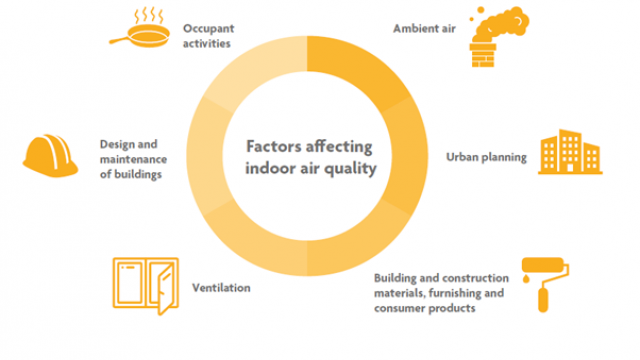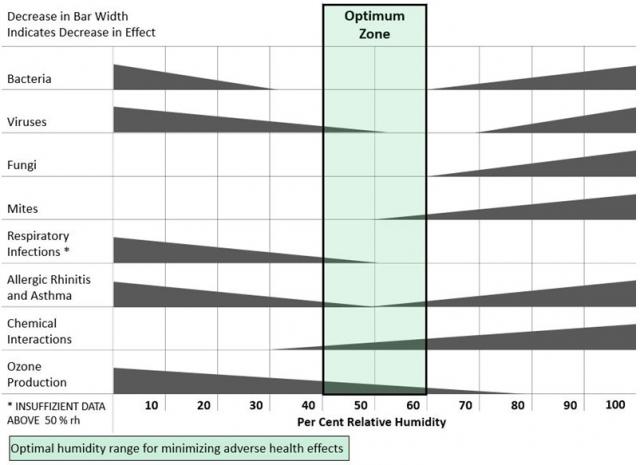Main
Like most of us, you probably try to eat and drink healthy. But what about breathing healthy? Well, here is some food for thought:
Every day, we breathe around 15 kg of air
Every day, we drink around 1.5 kg of liquid
Every day, we eat around 0.75 kg of food
These facts speak loudly, don’t they?
When talking about healthy air, the first question is: where do you breathe most of your air? Ninety percent of our lives on average, we are indoors, and the most vulnerable individuals among us, young children, the elderly and the chronically ill, often can rarely leave their indoor confines. Reports indicate air pollution (ultrafine particles) is 3.5 times worse in residential and commercial spaces than outdoors. And in indoor industrial environments, the air may be 50 times worse than outdoors.
The pollutants largely originate from inside the buildings, but outdoor pollutants are present as well, gaining access through insufficiently tight building envelopes or ventilation systems. Sometimes, energy-efficiency incentives or design requirements to tighten up buildings and ventilation systems result in less-than-optimal air exchange and as a consequence, greater levels of pollution in buildings. That means higher health risks for you.
Besides being our homes and workplaces
One study likens our homes to toxic boxes, which become a risk for us when we continuously breathe a toxic cocktail of combined indoor and outdoor pollutants. The study clearly shows the collective impact of pollutants from indoor and outdoor air is an even greater threat to our health.
Buildings typically are home to many sources of pollution. To maintain a healthy indoor environment, effective ventilation extracts used air and delivers fresh air. When fitted with an integral filter, such a system drastically reduces the number of harmful particles, such as visible ones like dust, but especially the smallest ones, that is, those that are less than a micrometer in size. Such particles are able to evade our bodies’ defense mechanisms, including our nose and mouth, and enter our blood streams.

Concentrations demand our concentration
There are indeed a host of pollutants, organic, inorganic and biological, in gaseous and particulate states that occur in our indoor spaces. Since there are thousands of these molecular pollutants, making it impractical to deal with them individually, we tend to group them together as Volatile Organic Compounds (VOCs), though there are many other molecular contaminants, such as NO2, H2S, etc. For more information, visit World Health Organization 'six major contaminant risks for humans.'
It is generally common knowledge that the hazards of excessive smoke in buildings from the burning of solid fuels and cigarettes; high carbon monoxide levels due to faulty heating appliances and radon emissions from granite under our buildings are all serious health threats. But there are more subtle toxic substances in our buildings, ones that are capable of adversely affecting our health, minimizing our sense of wellbeing, lowering our productivity and increasing absenteeism at the workplace.
Sources of indoor pollutants are diverse and are largely dependent on the type of building. Some of the common ones are:
Washing/cleaning
Furniture
Pets
Construction materials
Wood-burning appliances
Cooking
Smoking
Decorative indoor furnishings

It is important to note that these contaminant charts often fail to mention people as a major source of contaminants. Some airborne contaminants, like viruses, access indoor spaces primarily through people, not outdoor air.
And there is another vital but often overlooked aspect of Indoor air quality: relative humidity. If kept within a specific range, it adds yet another layer of protection that effectively and naturally shields us against viruses and other pollutants, while reducing chemical interaction, as the Sterling Chart below displays.

Greatest indoor health safety is with 40–60% relative humidity
We have seen in the scientific community and press in recent years many discussions on the topics of aerosolized viruses and indoor airborne transmission. Based on medical research, public awareness of the importance of humidity to maintaining healthy indoor environments is rising. Its significance to future facility management and building has received widespread attention and acknowledgement, and standards to protect the most vulnerable, namely our children, elderly and exposed workers, are currently under review.
Science tells us that for our health and wellbeing the indoor environments we frequent must maintain this healthy level of relative humidity because it:
Helps our immune system ward off viral infections
Helps us concentrate better at work and learning
Improves our sleep and sense of comfort in indoor spaces
Blesses us with healthier looking skin and reduces eye dryness and irritation
Find out more: Humidification: one of the best things you can do to the air you breathe
or listen to this insightful podcast: Low humidity’s impact on health.
We need to utilize all layers of protection in order to actively improve the protection of everyone’s health.
These articles might interest you as well:

ventilation
Ventilation and the health of your building
In our push to cut carbon emissions, the pressure to increase the energy-efficiency of our buildings is intensifying.

filtration
Knowing what you might be breathing
When pollutants present in the living spaces mix with those from outside, the toxicity of indoor air can reach levels up to 50 times that of outdoor air.

light
Light affects your wellbeing
Daylight is of huge importance to our wellbeing – biologically as well as psychologically.
